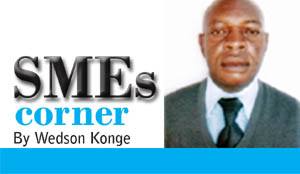 IN today’s column, I will look at one of the commonly used business terms, which are loosely applied, yet have a significant meaning to business situations.
IN today’s column, I will look at one of the commonly used business terms, which are loosely applied, yet have a significant meaning to business situations.
Assets and liabilities are terms that are loosely applied in business terms and yet are a strong foundation for any business.
Although a business venture is born as an idea in the mind of any prospective entrepreneur, the back-up plan to formulate it is capital.
Capital may be in the form of cash or property or a combination of both depending on the kind of business being pursued at a given time.
Assets and liabilities are the basis on which any business is founded and deeper understanding of their meaning is of paramount importance to entrepreneurs.
Business assets are belongings or properties or possessions tangible or intangible with value attached owned by a business that assist in the business operations.
While liabilities are anything a business does not own but used in the business operation and at later stage must revert to real owners.
A business may own machinery, delivery vans and computers to help it run the business in a more efficient manner for it to optimize profits.
Such possessions are described as tangible assets because one can touch and feel them.
While some money used to acquire such properties was borrowed and is expected to be paid back with interest, such borrowed funds or loans are called business liabilities.
A business owner may pump into a business a substantial amount of money to help it take off in its business operations and such interest from the business owners invested into a business is called capital and is a business liability.
In the event of the business winding up the business owner will claim back the capital that he put into a business.
Where cash is not enough to pay off the capital pumped in a business, tangible assets will be sold off to pay of the business owner.
However, before the interest of the business owner is taken care of, the business must first discharge the other business liabilities such as loans and other creditors like suppliers of goods and services.
It is important for business owners who are also entrepreneurs to understand what business assets and liabilities are in the business context.
For this reason accountants have devised an accounting tool called the balance sheet to show on the other-side the extent of asset ownership in a business and on the other hand, how the business assets where acquired through the business liabilities.
The balance sheet must always maintain the equation of liabilities equals assets.
A balance sheet as devised by the accountants is a snap-shot at any particular date that will bring into focus the total assets owned by the business and the extent to which the business is vulnerable to debt owing.
A good business will show on the balance sheet less outside borrowing but more of internally generated income through its business operations alongside the capital pumped into the business from business owners.
In this case the interest of the business owner apart from the initial capital pumped in will be represented in growth by internally generated funds.
Business that shows more of outside liabilities than income generated by it poses a danger in its growth because the outside interest may cause it to fold if claims are enforced on it by the outside claimants.
This is so because when demands are placed from where the loan was gotten due to time elapsing for payments and the suppliers of goods or services are demanding to be paid because time is due and that electricity and water bills that have been accrued over time are due, there should be enough liquid assets to pay for them.
A well constructed balance sheet will be able to portray the true standing of a business at that particular date.
That is why it is important for non financial entrepreneur to read and understand the balance sheet of their businesses periodically.
For any comments contact cell 0950458228 or email wklpublications699@gmail.com.






